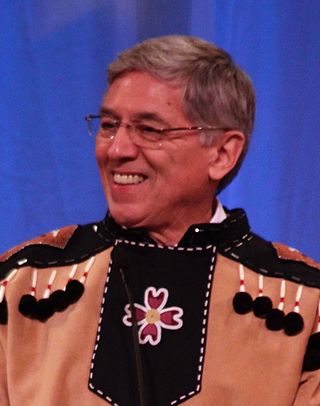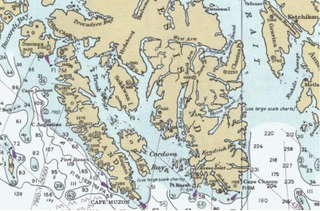Related Research Articles

The Tlingit or Lingít are Indigenous peoples of the Pacific Northwest Coast of North America and constitute two of the two-hundred thirty-one federally recognized Tribes of Alaska. Although the majority, about 14,000 people, are Alaska Natives, there is a small minority, 2,110, who are Canadian First Nations.

Hoonah–Angoon Census Area is a census area located in the U.S. state of Alaska. As of the 2020 census, the population was 2,365, up from 2,150 in 2010. It is part of the unorganized borough and therefore has no borough seat. Its largest community is the city of Hoonah.

The City and Borough of Yakutat is a borough in the state of Alaska. Yakutat was also the name of a former city within the borough. The name in Tlingit is Yaakwdáat. It is derived from an Eyak name, diyaʼqudaʼt, and was influenced by the Tlingit word yaakw.

The Saint Elias Mountains are a subgroup of the Pacific Coast Ranges, located in southeastern Alaska in the United States, Southwestern Yukon and the very far northwestern part of British Columbia in Canada. The range spans Wrangell-St. Elias National Park and Preserve in the United States and Kluane National Park and Reserve in Canada and includes all of Glacier Bay National Park in Alaska. In Alaska, the range includes parts of the city/borough of Yakutat and the Hoonah-Angoon and Valdez-Cordova census areas.

Yakutat Bay is a 29-km-wide (18 mi) bay in the U.S. state of Alaska, extending southwest from Disenchantment Bay to the Gulf of Alaska. "Yakutat" is a Tlingit name reported as "Jacootat" and "Yacootat" by Yuri Lisyansky in 1805.

Russell Fiord, also spelled Russell Fjord, is a fjord in the U.S. state of Alaska. It extends north to Disenchantment Bay, the terminus of Hubbard Glacier, at the head of Yakutat Bay. The fjord was named in 1901 by Marcus Baker of the U.S. Geological Survey for explorer Israel Russell, who discovered the estuary in 1891 while exploring the Yakutat region.

Yakutat Airport is a state-owned public-use airport located three nautical miles (6 km) southeast of the central business district of Yakutat, a city and borough in the U.S. state of Alaska which has no road access to the outside world. Airline service is subsidized by the Essential Air Service program.
Poa Island is an islet located about 0.99 miles (1.59 km) off the south coast of Akun Island in the Fox Islands group of the eastern Aleutian Islands, Alaska. The island is 0.62 miles (1.00 km) long and reaches a maximum elevation of about 200 feet (61 m) above sea level. It was named for a genus of grasses in 1888 by the U.S. Bureau of Fisheries. Captain Tebenkov (1852) called it "Ostrov Tumannyi," meaning "foggy island."

Yakataga Airport is a public use airport serving Yakataga in the U.S. state of Alaska. It is owned by Federal Aviation Administration and lies in the western section of Yakutat Borough.

Nora Marks Keixwnéi Dauenhauer was a Tlingit poet, short-story writer, and Tlingit language scholar from Alaska. She won an American Book Award for Russians in Tlingit America: The Battles of Sitka, 1802 And 1804. Nora was Alaska State Writer Laureate from 2012 - 2014.
Icy Bay Airport is a private use airport serving Icy Bay, in the Yakutat City and Borough of U.S. state of Alaska. It is owned by Alaska Mental Health Trust.

USS Yakutat (AVP-32) was a United States Navy Barnegat-class small seaplane tender in commission from 1944 to 1946. Yakutat tended seaplanes in combat areas in the Pacific during the latter stages of World War II. After the war, she was in commission in the United States Coast Guard from 1948 to 1971 as the Coast Guard cutter USCGC Yakutat (WAVP-380), later WHEC-380, seeing service in the Vietnam War during her Coast Guard career. Transferred to South Vietnam in 1971, she was commissioned into the Republic of Vietnam Navy as the frigate RVNS Trần Nhật Duật (HQ-03). When South Vietnam collapsed in 1975 at the end of the Vietnam War, she fled to the Philippines, where the Philippine Navy took custody of her and cannibalized her for spare parts until discarding her in 1982.
The Yakutat Block is a terrane in the process of accreting to the North American continent along the south central coast of Alaska. It has been displaced about 600 km (370 mi) northward since the Cenozoic along the Queen Charlotte-Fairweather fault system. The block subducts between this fault system and the Alaska-Aleutian Subduction Zone. The thickness of the Yakutat Block varies, ranging from approximately 15 km in the west to 30 km in the east.
New Russia was a trading-post for furs and a penal colony established by Russians in 1796 in present-day Yakutat Borough, Alaska. It was presumably named after the Joseph Billings ship Slava Rossii, or "Glory of Russia".

Byron Ivar Mallott was an American politician, elder, tribal activist, and business executive from the state of Alaska. Mallott was an Alaska Native leader of Tlingit heritage and the leader of the Kwaash Ké Kwaan clan. He was the 12th lieutenant governor of Alaska from December 2014 until his resignation on October 16, 2018. He also previously served as the mayor of Yakutat, the mayor of Juneau, the president of the Alaska Federation of Natives and the executive director of the Alaska Permanent Fund.

The Situk River in the Gulf of Alaska Watershed drains a portion of Yakutat City and Borough, Alaska. The Alaskan natives name was reported as R(eka) Sita or Sitak River by Captain Tebenkov, Imperial Russian Navy (IRN). It was spelled Situk by E. J. Glave in 1890, and See-tuck by Lieutenant Commander J. F. Moser, U.S. Navy (USN), in 1901.

Cape Yakataga is a community in the City and Borough of Yakutat of the U.S. state of Alaska. Also known as Yakataga, its coordinates are 60°03′59″N142°25′51″W and its elevation is 20 feet (6 m).
Elaine Elizabeth Abraham was a Yakutat Tlingit Tribe elder and registered nurse who contributed to improving health care delivery in rural Alaska. Later active professionally in the field of education, she assisted with the creation of the Alaska Native Language Center, and, as a statewide administrator at the University of Alaska, in 1976, led the establishment of community colleges in underserved parts of the state.

Kaigani Strait is a waterway in the U.S. state of Alaska, the southern part of the strait between Long Island and Dall Island. The Alaska Native name, as reported by Etolin is 1833, is Kalgan.

During September 1899 there was a series of severe earthquakes in the region around Yakutat Bay in Alaska. The most powerful of these occurred on September 3 and September 10 at about noon, local time. The area was sparsely populated and no fatalities were recorded, but the earthquakes were notable for the degree of elevation recorded, up to 47 feet, and for the effects on the glaciers in the region. Fieldwork on the effects of the earthquake was carried out between 1905 and 1910, and a summary report was published in 1912. The September 3rd large shock's magnitude is debated, but it ranges from 8.2–8.5. The second earthquake on September the 10th was also a comparably large shock, with magnitudes ranging from 8.2–8.6.
References
- ↑ Stephen Denison Peet (1897). The American antiquarian and oriental journal. Jameson & Morse. p. 20. Retrieved 17 April 2011.
- ↑ "Native American (Yakutat)". The Metropolitan Museum of Art.